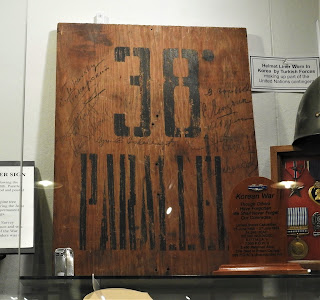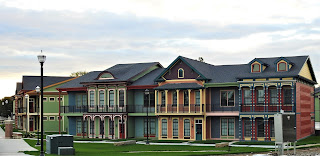What a drive today! We took the country roads, not a freeway in sight! It was green, grassy, hilly and sunny driving past the plowed fields and through small towns of America’s breadbasket. The narrow roads do keep you on your toes, I’ll say, but it was peaceful and scenic. We are parked at Ouabache (pronounced, “wabash”) Trails Park. It was sunny when we arrived but the rain persistently returns.
 |
| Machine gun cart WWI - note the horse wearing a real gas mask |
 |
| WWI German machine gunner's breast plate |
 |
| Gen. John Pershing's phone at headquarters in Chaumont, France |
 |
| Gen. George S. Patton's dress uniform |
 |
| 1870 US Cavalry dress uniform with helmet |
 |
| One of the first 38th parallel signs placed by the US military after the surrender of Japan in 1945. Later, they were replaced by permanent metal markers. |
Like all museums, it would take weeks to see all the individual pieces and read all of the plaques but there are some things that deserve a second look and a little study. Some are original and one of a kind pieces and it is amazing that Jim has acquired this unique collection.
 |
| Drummer Boy uniform circa Civil War Era |
 |
| Uniform of Clarence Dowden, Jr. Last active enlisted man of WWII |
 |
| Every town in Germany had an Adolf Hitler Street. This sign was stolen by a US soldier when the war was ended |
 |
| May 7, 1945 issue of Time Magazine |
 |
| April 23, 2003 issue of Time Magazine |
Outside, among other aircraft and missiles is the sail or “conning tower” of the SS Indianapolis. This is the tower from which the commander controls the movements of the ship when on the surface. The sub was built for $900M and commissioned in 1977. It was scrapped in 1998. It would have been cool to go in the sail but it was not accessible to us tourists.
 |
| "Sail" or "Conning Tower" of the sub SS Indianapolis |
We stayed and studied everything
we could until our welcome ran out and we were told it was closing time. We had the honor of meeting Judge Jim and talking
with him and then went on our way.
 |
| Home of William Henry Harrison |
While driving about town, we were surprised by the gigantic old houses on the small streets and how beautifully restored many of them are. One beautiful old building dating back to 1803 is the home of William Henry Harrison. He was appointed as the Governor of the Indiana Territory by President John Adams and lived in this house until he became the ninth President in 1841. (He was the President for only 31 days and was the first to die in office. John Tyler succeeded him.)
 |
| Knox County Courthouse |
 |
| Pretty painted apartment buildings |
 |
| Reminds me of "Wedding Cake Row" in Charleston, SC |
We found The Café Moonlight in this town and had a nice quiet seafood dinner there. We could actually see ourselves living in pretty little Vincennes but it loses our vote with all this rain. Once again, it rained all night. This morning, we set out for St. Charles, MO. The road (Hwy 50) is rough and bumpy with cracks and potholes that rattle our teeth but it goes through many tiny little towns, vast farmlands and serene green acres and beats driving on the freeway.
Oh my!!!
ReplyDeleteMore amazing pictures and stories.
Your efforts are always appreciated.
We long to hit the road, but tagging along with you guys is as good as it gets till next year.
Happy Traveling.
F & L
Very interesting as usual. You never cease to amaze me. I forget someone's name about 8 seconds after being introduced.
ReplyDeleteCarolyn
That was very, very interesting. Thanks for sharing this!
ReplyDeleteyou found a neat museum!
ReplyDeleteVery cool Lindy!! You can tell me what little town is the best place to move (I'm with you on the rain)because I don't know how we're going to stay in California?!!!
ReplyDeleteI agree with EVERY comment!! Keep up the good work, and don't end this trip! I'm enjoying it too much.
ReplyDeleteHave never heard of Vincennes, IN, but I enjoyed learning about it from your T-Log. Would love to visit that museum. Fun to take the back roads and see parts of our country you would never see from a freeway, especially the pretty little towns in the heartland. Sharon
ReplyDelete